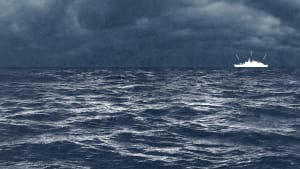Joel Mathis – Yesterday 7:39 PM
The sinking of Russia’s flagship might be a bad sign for the U.S. Navy
It’s tempting for Americans to get smug about the sinking of the Moskva, the Russian Navy’s flagship in the Black Sea. Whether it was destroyed by Ukrainians or — less plausibly — sunk because of a non-combat onboard explosion of ammunition, the result is both a humiliation and a setback for Vladimir Putin’s war efforts. If you’re cheering Ukraine’s defenders, it’s hard not to take some satisfaction in that.
But America’s fleet might also be more vulnerable than you think.
For several years now, going back to a pair of collisions separately involving the U.S.S. John S. McCain and U.S.S. Fitzgerald in 2017, there have been a series of reports indicating that the U.S. Navy is overstretched, overworked, and under-maintained, and thus increasingly vulnerable as it goes about the expensive task of patrolling the world’s oceans.
A February report by the Government Accountability Office broke down the ugly details of how Navy personnel are struggling to keep their ships running properly. “Some crewmembers provided examples of parts such as electrical safety equipment being on backorder for up to 2 years and described difficulties locating consumable materials such as filters, specific types of oil, and protective clothing for themselves,” the GAO reported. “Ten of the 16 ships’ crews we met with stated that they resorted to cannibalizing parts — that is, taking functional parts away from other ships, in turn leaving them less-than-operational — so their respective ships could remain operational.”
America might have what is regarded as the most powerful navy in the world — China has the largest, but many of its ships are smaller — but it is clearly fragile. And that’s a problem.
“The U.S. Navy is on the verge of strategic bankruptcy,” Christopher Dougherty, a former assistant defense secretary, wrote last year. “Its fleet isn’t large enough to meet global day-to-day demands for naval forces. Due to repeated deployments and maintenance backlogs, the fleet also isn’t ready enough to meet these demands safely, nor can it quickly surge in an emergency.” He concluded that “the risk of its debts coming due suddenly (and perhaps violently) will increase.”
Even without those challenges, there is also the question of whether the U.S. Navy is built for the modern world.
Just as aircraft carriers once replaced battleships as the backbone of the fleet, there are now questions about whether America’s carrier-based fleet is overly vulnerable to a new generation of Chinese anti-ship ballistic missiles. And those questions are likely to get more pertinent if it turns out the Ukrainians really did take out the Moskva with their new Neptune missile.
America has spent much of the 21st century learning that the overwhelming power of its armed forces isn’t always so overwhelming. The sinking of the Moskva is a sign that such a lesson might also extend to the U.S. Navy. Finding out the hard way might be disastrous.




